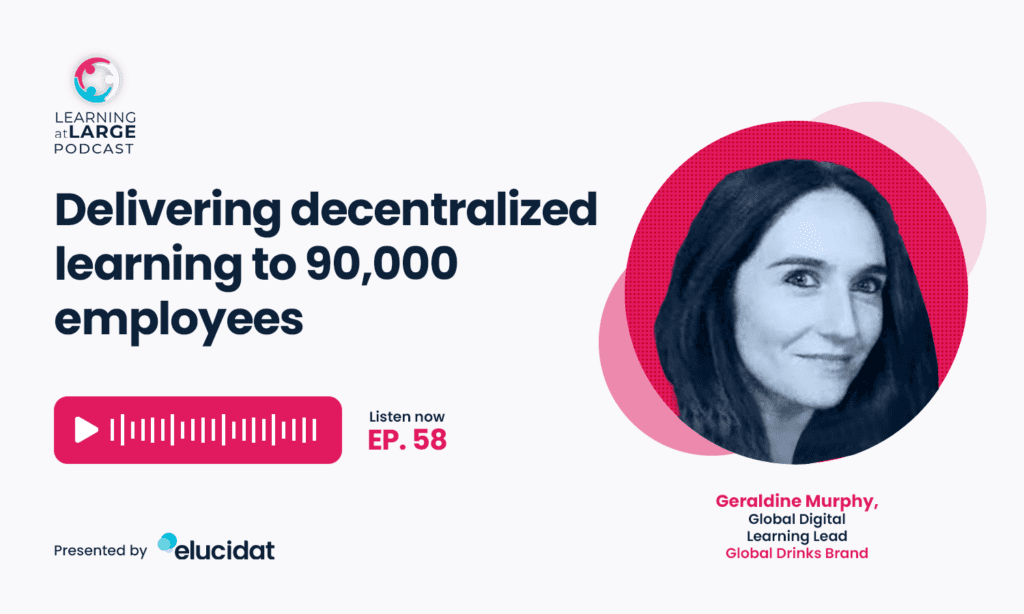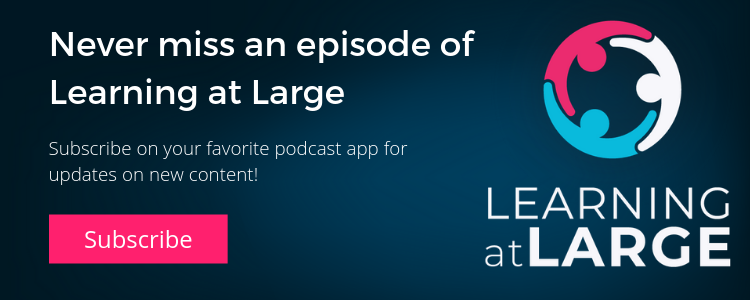Delivering Decentralized Learning: Geraldine Murphy
Producing effective learning at scale isn’t straightforward. Add a decentralized learning model to the mix and things can get even more complicated. We found out how Geraldine Murphy, global digital learning leader, approaches this challenge at one of the world’s largest drinks brands. Hear how she’s driving standards against a backdrop of constant demand from a range of operating companies. Discover the skill and mindset you need to balance global strategies with local needs.

Top tips for delivering decentralized learning at scale
Don’t have time to listen now? Here are some top tips from Geraldine:
- Add some glocal flavor: Your learning ecosystem needs to work across your business. Combine your global offer with the best local initiatives.
- Keep it relevant and meet demand: In a decentralized model, one size doesn’t fit all. If learning is going to have impact, it needs to be relevant and delivered quickly.
- Move from reactive to strategic: Step back from the rush to meet demand. Explore collaborative ways of working that meet the whole business’ needs.
- Create a framework to harness expertise: There’s a wealth of experience in your organization. Develop a flexible framework empowers your people to produce effective learning.
1. Add some glocal flavor
Responsible for the development of 90,000 employees across the globe, Geraldine is delivering learning at a huge scale. But it’s the structure that makes things really complex.
With 85 operating companies working largely autonomously, creating a learning ecosystem that’s right for everyone isn’t straight forward. On the one hand you have the global strategic goals of the business, and on the other the day-to-day needs of the individual companies. Don’t focus on one to the detriment of the other. For Geraldine, it’s all about balance.
“I’m trying to bring a bit of that glocal flavor to the business. I think that’s where we’re going to be able to make the most traction and get the best outcomes – if we can surface the best of the global offer and the local initiatives, and also utilize the wealth of experience in L&D across those operating companies. So that it doesn’t always feel from a top-down global perspective.”
2. Keep it relevant and meet demand
When your organization has lots of functions with a variety of needs, learning can be very different across the business. So, what does good look like?
Geraldine highlights that there isn’t one thing that works. Whatever you do in L&D, it needs to be highly relevant and contextualized. It has to be available in local languages with local reference points. And with business gathering pace every single day, it’s critical that learning is delivered quickly.
“I can’t say one thing that works. But it really is about addressing those functional needs. Making sure it’s adaptable and relevant and delivered quickly. Because one thing that we struggle with in this kind of decentralized model, and at a global level, is keeping up and producing at the pace that’s required.”
3. Move from reactive to strategic
Geraldine joined her company last November. At that time, the organization was still in the post COVID digital learning delivery rush.
Now out of that push to deliver, she’s been able to take a step back to think about how L&D partner with the business to get the best outcomes. This means moving from being reactive to strategic. It starts with L&D developing new collaborative ways of working. Whether it’s triaging business needs or cascading strategy through the organization, it needs to be a collaboration.
“If you can make a direct link, and be part of an active community of practice, that’s going to make the cascading of that strategy more impactful, because you can talk about it. It’s not just a piece of paper. It’s not just a tagline. We want it to feel real and feel different for the business. And in that way, we have to be really clear on the impacts and the gains for everybody working in L&D across the business.”
4. Create a framework to harness expertise
With limited inhouse learning design resource, Geraldine’s business relies on their internal experts to develop learning. These employees are experts in their field, but they’re not experts in delivering learning.
If these SMEs are going to produce learning that delivers impact, they need a framework for success. And with a range a business needs to meet, this can’t be too strict. The set of principles need to be clear and consistent, but also flexible so everyone can bring their best to the table.
“We can’t do it alone. For [our complex] business challenges, it can’t just be the L&D team addressing this alone. It has to be done in partnership. Subject Matter Experts own the content. We own the framework. And together, we can create something more impactful.”
A quick recap
Delivering effective L&D isn’t always easy in large, complex organizations. Geraldine has four strategies for developing a decentralized learning model that maintains standards.
- Combine the best of your global offer and local initiatives.
- Make sure all learning is relevant and delivered quickly.
- Move from reactive to strategic so you can meet the real business needs.
- Harness your internal expertise with a flexible framework for quality learning.
Want to find out more? Check out the full podcast.
About Geraldine
Since completing her teacher training just under 15 years ago, Geraldine has held a variety of positions in further and higher education. More recently she’s pivoted to the corporate setting as Global Digital Learning Lead for one of the world’s largest drinks brand.
You can find out more and get connected with Geraldine on LinkedIn.
On Geraldine’s reading list
Find out what reading informs Geraldine’s approach to delivering impactful learning experiences.
Geraldine recommends this book for tips to help you deal with stakeholders in large and diverse businesses.
Writing Is Designing: Words And The User Experience, Michael J. Metts, Andy Welfle, Nick Madden
This book is a practical look at how writing is critical to crafting an effective user experience.
Looking for more reading tips? Check out our book blog.
Join the conversation!
We’d love to hear your thoughts on our podcast, so feel free to get in touch with our podcast host, at kirstie.greany@elucidat.com. As always, don’t forget to subscribe to Learning at Large in your favorite podcast app and leave us a 5-star rating if you enjoyed it. Thank you for joining us, and see you next time.
